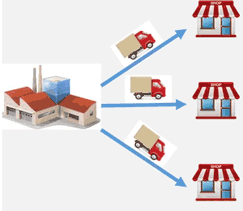Is the long standing practice of direct store delivery for some product categories coming to an end?
That after news in early May that Nestle US was ending its DSD program for many of its products, in a model that seems to be about disappearing outside of bread, soda and beer.
Supply Chain Digest Says... |
|
|
Nestle will instead ship goods to retailer DCs for them to move to individual stores - meaning lots of drivers, merchandisers and other staff are no longer needed – with some 4000 jobs to be lost, Nestle days.
The company said May 7 that it is shutting down its direct-to-store delivery network for products such as DiGiorno and Skinny Cow, beginning in the third quarter of 2019. That means the elimination of an operation that now includes 230 facilities, 1,400 trucks and 2,000 different delivery routes.
The unit was able to reduce costs but, ultimately, the direct store model was too expensive even once the company "reached the maximum point of efficiency," Steve Presley, CEO of Nestle USA, said - meaning previous cost cutting moves weren't enough in the end.
"You can't have that duplicative cost in the structure," Presley added, referring to both a retailer and some vendors making deliveries to stores.
Similarly, In 2017, Kellogg announced plans to eliminate 1,200 distribution jobs as it exited direct store delivery in its snack business unit to cut logistics costs. That business has now moved to a retail DC store replenishment model, as Nestle is now planning to also pursue.
"Because our customers' and our own warehouse distribution systems have become more efficient and effective, we can now redeploy resources previously tied to DSD and direct them to the kinds of brand investments that drive greater demand with today's consumers," Kellogg CEO John Bryant said at the time.
Paul Norman, president of Kellogg North America at the time, said that "We see the warehouse model as a clear advantage for us. In fact, we realize both higher service levels and share in the US Snacks categories and channels that sell through warehouse distribution already."
Kellogg's move led to the closure of 39 distribution centers and roughly 1,100 layoffs.
In 2012, after bakery snack maker Hostess went under and then was reborn under new management, it also took a hard look at its DSD model with a fresh set of eyes.
At its peak, Hostess had thousands route trucks and 600 storage depots. The new owners decided it would end DSD and ship to retail DCs, which in the end not only took out lots of logistics costs but actually led to more stable demand and better forecast accuray.
Snack giants Mondelez International and PepsiCo's Frito-Lay both still rely on DSD, arguing it helps boost sales to have employees in stores stocking products and ensuring freshness – at least for now.
State laws often mandate direct store delivery in categories such as beer and soft drinks. Breads makers still use DSD due to freshness and handling challenges.
Mondelez logistics managers gave a presentation at the CSCMP annual conference in 2014 that discussed how it was improving the DSD process - but at the same time highlighted its costs.
(See More Below)
|
CATEGORY SPONSOR: SOFTEON |
|
|
| |
|
|
 Mondelez (created when Kraft split into two companies in 2012) noted, for example, that there are multiple roles applied to a retail customer in Mondelez's direct store delivery model: a route driver, a merchandiser, a sale rep, and customer service. While naturally they all need to work together, they weren't really tied together by technology at Mondelez, a condition in part the result of the roles falling under different corporate command structures (logistics, sales, etc.). Mondelez (created when Kraft split into two companies in 2012) noted, for example, that there are multiple roles applied to a retail customer in Mondelez's direct store delivery model: a route driver, a merchandiser, a sale rep, and customer service. While naturally they all need to work together, they weren't really tied together by technology at Mondelez, a condition in part the result of the roles falling under different corporate command structures (logistics, sales, etc.).
That meant, for example, that if a delivery driver was late - which they often were - a merchandiser may have been stuck waiting unproductively at a store until the driver shows up. Mondolez said at the conference that it was making progress is on technology and process change in which all these parties would connected. The dispatch of merchandisers, was becoming directly to the driver's real-time ETA. Merchandisers themselves were placed on a workforce management system, similar to an engineered labor standards system in a distribution center, that calculates how long each store stop should take considering units delivered, what SKUs, characteristics of the retailer, etc.
It was a strong story, and made more so by Mondelez's vision for even more autonomous systems ultimately "perfect logistics," with complere syncronization DSD process and people.
It sounded very good - but involves a lot of labor. Whether the DSD model can stand when it can be realistically replaced with shipping instead to retail DCs is a real question.
"The unspoken truth is that the DSD channel is a very expensive supply chain for moving many food products to market," note the consultants at MWPVL International on their web site.
Do you see hope for the DSD model, or will it soon largely go away?Let us know your thoughts at the Feedback section below.
|
|
Pat Myaz
Lead, North Brewing Company |
Posted on: Apr, 15 2020 |
|
| It's definitely sticking around for good. Look at the alcohol tiered system. |
|
|